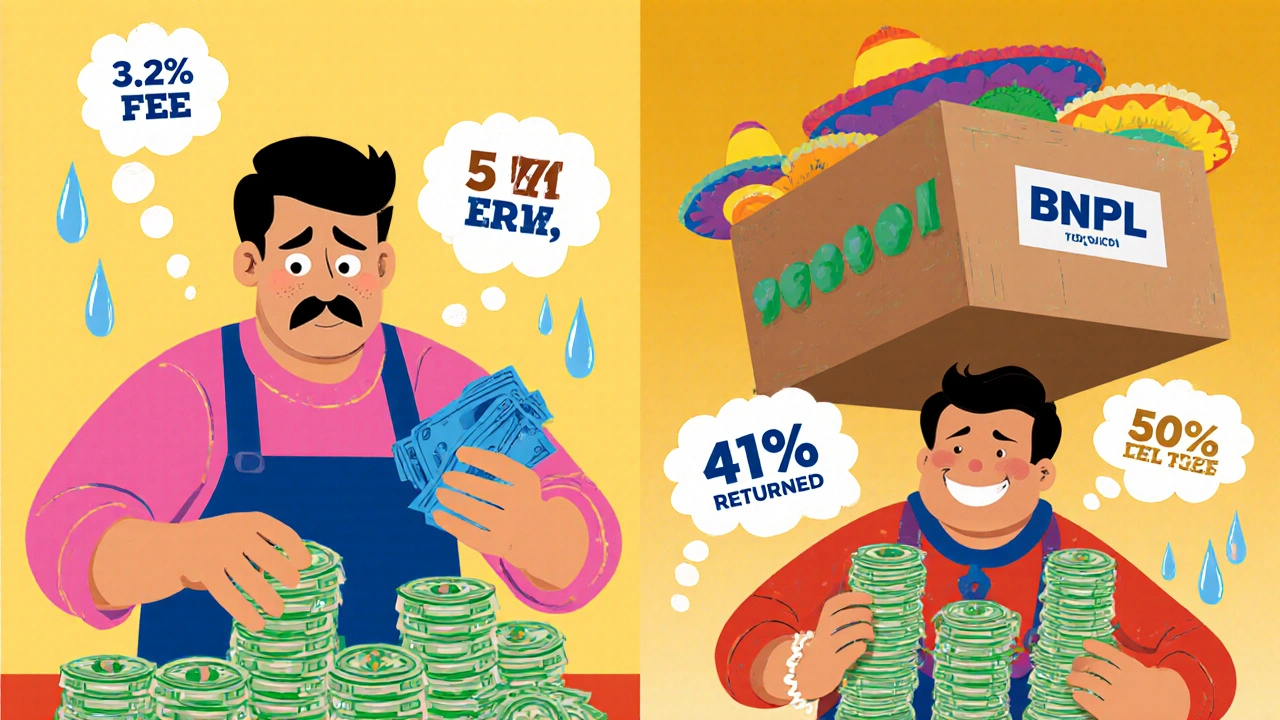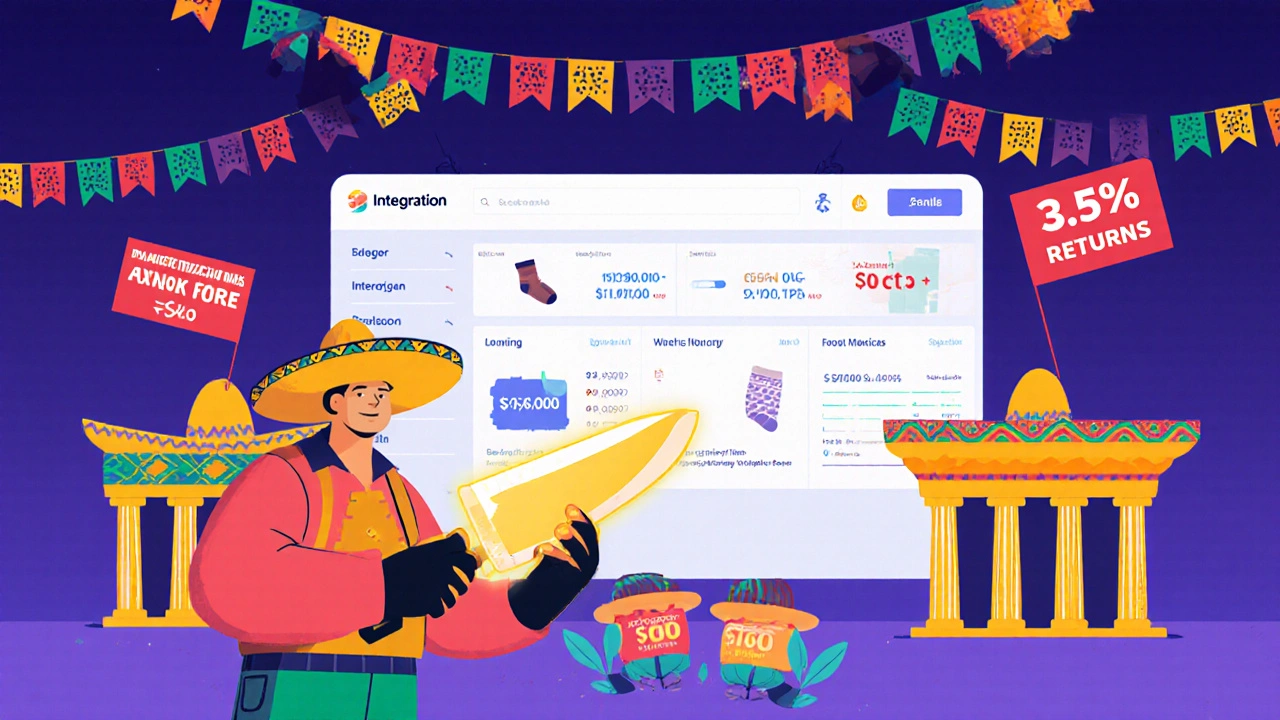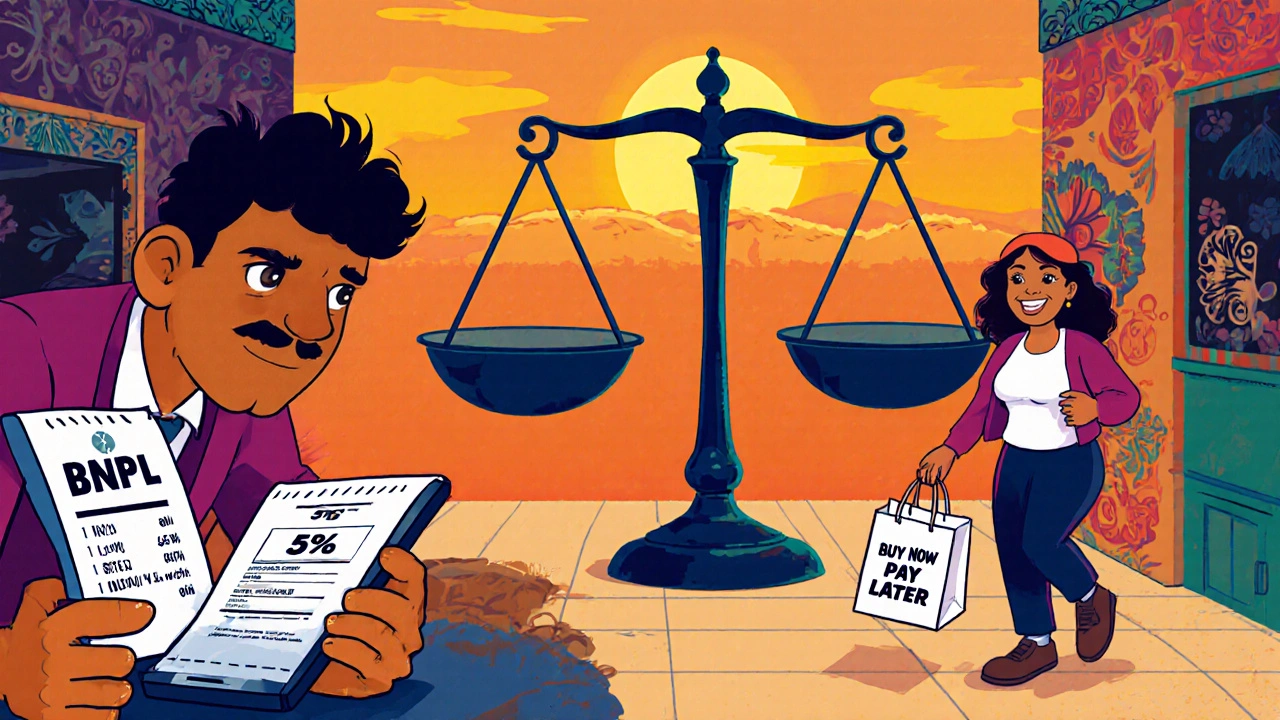BNPL Profitability Calculator
BNPL Impact Calculator
Calculate whether offering BNPL payment options will increase or decrease your profit margins based on your specific business metrics. Input your current business data to see the financial impact.
Results
When you check out online and see BNPL as a payment option, it feels like a gift: pay in four easy installments, zero interest, no credit check. But that convenience isn’t free. Someone’s paying for it-and more often than not, it’s the retailer. In 2025, BNPL merchant fees average 4% to 6% per transaction. That’s nearly double what most stores pay for credit card processing, which sits at 2.5% to 3.5%. For a small business with 15% profit margins, that’s not a small cost. It’s a razor’s edge.
Why Retailers Pay So Much for BNPL
Merchants don’t accept BNPL because they like paying more. They do it because sales go up. According to the Federal Reserve Bank of Richmond’s 2025 report, stores that offer BNPL see conversion rates jump by up to 30%. That means more people complete their purchase instead of abandoning their cart. Even more powerful: average order values rise 20% to 40%. A customer who hesitates at $80 might happily click "Buy Now, Pay Later" if they can split it into four $20 payments. That’s not just a sale-it’s a bigger sale. Fashion and home goods retailers are seeing the biggest lifts. One Colorado-based apparel store reported that BNPL pushed their average order from $68 to $94. That’s a $26 bump per transaction. Even with a 5% fee ($4.70), they still came out ahead. But that math only works if your product margin is high enough. If you’re selling t-shirts with a 12% margin, that $4.70 fee eats up nearly half your profit. That’s why successful merchants don’t offer BNPL on everything.BNPL vs. Credit Cards: The Real Cost Difference
Let’s break it down. A typical credit card transaction costs a small business 3.2% in processing fees. A BNPL transaction? 5%. That’s a 56% increase in cost per sale. But here’s the catch: BNPL isn’t just a payment method. It’s a psychological tool. Studies show that consumers spend more when they don’t see the full price upfront. It’s not magic-it’s behavioral economics. Credit cards are a direct charge. BNPL is a subsidy. Retailers are effectively giving interest-free loans to price-sensitive shoppers while charging full price to others. That’s price discrimination, and it works. But it’s not sustainable if the cost outweighs the gain. When BNPL fees rise to 7% or 8%-as they do with some providers-many small retailers start asking: Is this worth it?Who’s Getting Hurt? The Margins
Finaloop’s 2025 analysis of 2,500 e-commerce stores found that 63% of merchants see BNPL fees as a serious threat to profitability. For businesses with margins below 15%, the numbers get brutal. One Michigan-based outdoor gear store cut BNPL from its checkout after noticing that 41% of BNPL orders were returned-compared to just 22% for credit card purchases. Returns cost money, and BNPL returns are harder to manage. The customer gets their money back, but the merchant still paid the 5% fee upfront. Another common issue: tighter credit approvals. In Q1 2025, 52% of merchants reported fewer BNPL approvals due to stricter underwriting. That’s because BNPL providers are feeling the heat. With U.S. household debt hitting $18.2 trillion and delinquency rates climbing to 34-41%, providers like Klarna and Affirm are pulling back. Less approval = fewer sales. That’s the opposite of what merchants signed up for.
How Smart Merchants Use BNPL
The winners aren’t the ones who offer BNPL everywhere. They’re the ones who use it like a scalpel, not a sledgehammer.- They restrict BNPL to orders over $100. Data from 1,200 merchants shows this keeps margins intact-85% of original profit stays in place.
- They avoid using it on low-margin items like socks, phone cases, or clearance goods.
- They track weekly: not just conversion rates, but net margin after fees, returns, and chargebacks.
The New Competition: Banks Are Getting Involved
BNPL used to be the domain of startups like Afterpay and Klarna. Now, banks are stepping in. ItsCredit reports that 32% of major U.S. retailers have switched to bank-offered installment plans. Why? Because banks charge 2.5% to 4.5%-often lower than third-party BNPL-and they’re already in the merchant acquiring business. No new contracts. No new tech. Just plug into your existing payment processor. Banks don’t need to spend millions on marketing to attract users. They already have customers. They’re offering installment plans as a loyalty perk. And they’re reporting payments to credit bureaus-something most BNPL providers still don’t do consistently. That’s a big deal. Regulators are pushing for more transparency, and banks are ahead of the curve.
What’s Next for BNPL?
The BNPL industry is at a turning point. In 2024, global transaction volume hit $215 billion. It’s expected to grow to $350 billion by 2027, but the growth rate is slowing-from 40% a year in 2021 to just 25% in 2025. Why? Because the low-hanging fruit is gone. Most shoppers who want BNPL already use it. Regulators are watching closely. The CFPB’s new rules, effective January 2025, require BNPL providers to check affordability and report payment history to credit bureaus. That’s good for consumers. But it’s bad for BNPL providers’ growth. More checks = fewer approvals = fewer sales. Providers are responding. Affirm launched "Affirm Direct" in March 2025, offering lower fees to merchants who integrate directly. Klarna introduced a revenue-share model-fees adjust based on how much sales actually increase. The bottom line? BNPL isn’t going away. But it’s changing. The era of paying 6% for a 30% sales boost is ending. The future belongs to merchants who treat BNPL like a strategic tool, not a default option. And to providers who can lower fees without increasing risk.Should You Offer BNPL?
Ask yourself these questions:- What’s your average product margin? If it’s under 25%, BNPL is risky.
- Do you sell high-ticket items? If yes, BNPL could help. If you sell $20 items, probably not.
- Are your returns high? BNPL increases return rates by 15-20%. Can you absorb that?
- Can you restrict BNPL to orders over $100? If not, you’re likely losing money.
What Happens If You Don’t Offer BNPL?
Some merchants think they can ignore it. They can’t. In 2025, 6% of all U.S. e-commerce sales happen through BNPL. That’s up from 2% in 2020. If you’re in fashion, beauty, or home goods, you’re already losing sales to competitors who offer it. The question isn’t whether to offer BNPL. It’s how to offer it without killing your margins. The smartest retailers aren’t the ones who offer the most payment options. They’re the ones who choose the right ones for the right products-and know exactly how much each one costs them.How much do BNPL merchant fees typically cost?
BNPL merchant fees range from 2% to 8% per transaction, with an average of 4% to 6%. This is significantly higher than credit card processing fees, which average 2.5% to 3.5% for small U.S. businesses in 2025. Fees vary by provider, merchant volume, and integration method-direct API connections often cost less than third-party plugins.
Why do merchants accept BNPL if the fees are so high?
Merchants accept BNPL because it increases conversion rates by up to 30% and lifts average order values by 20% to 40%. Even with higher fees, many retailers see a net gain in revenue and profit-especially when BNPL is restricted to higher-margin products or minimum order values. The increased sales volume often outweighs the cost per transaction.
Is BNPL more expensive than credit cards?
Yes, BNPL fees are typically 60% to 100% higher than credit card processing fees. While credit cards cost 2.5%-3.5%, BNPL averages 4%-6%. However, BNPL isn’t just a payment method-it drives higher spending behavior. The extra cost can be justified if it leads to significantly larger orders or more completed sales.
Do BNPL purchases have higher return rates?
Yes. BNPL purchases have 15% to 20% higher return rates than standard credit card purchases. This is likely because shoppers feel less financial pressure when paying in installments. Merchants must account for these returns when calculating net profit, since they still pay the BNPL fee even if the item is returned.
Are banks replacing BNPL providers?
Yes. In 2025, 32% of major U.S. retailers now use bank-offered installment plans instead of third-party BNPL providers. Banks charge lower fees (2.5%-4.5%) because they already have merchant acquiring infrastructure and customer relationships. They also report payments to credit bureaus, which helps them comply with new regulations and appeal to risk-averse consumers.
What’s the minimum profit margin needed to use BNPL profitably?
Most successful merchants need at least a 25% to 30% product margin to absorb BNPL fees without hurting profitability. Stores with margins below 15% often reduce or eliminate BNPL options. Restricting BNPL to higher-priced items (over $100) helps maintain margins even with higher fees.
Will BNPL fees go down in the future?
BNPL fees may decrease if providers can reduce risk and improve efficiency. Affirm and Klarna have already introduced lower-fee models for direct integrations. Regulatory pressure and competition from banks are pushing providers toward more sustainable pricing. Experts predict fees could stabilize at 3%-4% by 2027 if providers balance consumer protection with merchant economics.

RAHUL KUSHWAHA
November 16, 2025 AT 09:21Man, I’ve seen this play out in my small online store selling desi jewelry. BNPL brought in more sales, but returns? Oh boy. Half my BNPL orders came back because people bought stuff they didn’t really need-just because it felt ‘affordable.’ Now I only offer it on items over $120. And yeah, I still pay the 5%, but at least I’m not bleeding profit on $20 bangles. 😅
Julia Czinna
November 16, 2025 AT 19:15It’s fascinating how behavioral economics silently reshapes retail. The real issue isn’t the fee-it’s that merchants are using BNPL as a crutch instead of a tool. I’ve worked with boutique owners who turned BNPL into a strategic filter: only on high-margin, high-emotional-value items. That’s not guesswork. That’s smart pricing. And the banks stepping in? Long overdue. Credit bureaus reporting payments finally forces accountability. No more ‘buy now, regret later’ without consequences. This isn’t just about fees-it’s about sustainable consumer behavior.
Laura W
November 18, 2025 AT 00:59Let’s be real-BNPL is the new ‘free shipping.’ If you don’t offer it, you’re invisible. But here’s the kicker: the ones winning aren’t the ones slapping it on every product. They’re the ones using it like a scalpel. $100+ minimum? Check. No BNPL on socks or clearance? Check. Direct API with Shopify/Shop Pay? Double check. I’ve seen stores cut their effective fee from 5.8% to 3.9% just by switching providers and gating it right. And banks? They’re not replacing BNPL-they’re upgrading it. Lower fees + credit reporting = win-win. The game’s changing. Adapt or get left behind.